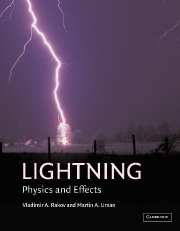Book contents
- Frontmatter
- Contents
- Preface
- 1 Introduction
- 2 Incidence of lightning
- 3 Electrical structure of lightning-producing clouds
- 4 Downward negative lightning discharges to ground
- 5 Positive and bipolar lightning discharges to ground
- 6 Upward lightning initiated by ground-based objects
- 7 Artificial initiation (triggering) of lightning by ground-based activity
- 8 Winter lightning in Japan
- 9 Cloud discharges
- 10 Lightning and airborne vehicles
- 11 Thunder
- 12 Modeling of lightning processes
- 13 The distant lightning electromagnetic environment: atmospherics, Schumann resonances, and whistlers
- 14 Lightning effects in the middle and upper atmosphere
- 15 Lightning effects on the chemistry of the atmosphere
- 16 Extraterrestrial lightning
- 17 Lightning locating systems
- 18 Deleterious effects of lightning and protective techniques
- 19 Lightning hazards to humans and animals
- 20 Ball lightning, bead lightning, and other unusual discharges
- Appendix: Books on lightning and related subjects
- Index
5 - Positive and bipolar lightning discharges to ground
Published online by Cambridge University Press: 05 June 2013
- Frontmatter
- Contents
- Preface
- 1 Introduction
- 2 Incidence of lightning
- 3 Electrical structure of lightning-producing clouds
- 4 Downward negative lightning discharges to ground
- 5 Positive and bipolar lightning discharges to ground
- 6 Upward lightning initiated by ground-based objects
- 7 Artificial initiation (triggering) of lightning by ground-based activity
- 8 Winter lightning in Japan
- 9 Cloud discharges
- 10 Lightning and airborne vehicles
- 11 Thunder
- 12 Modeling of lightning processes
- 13 The distant lightning electromagnetic environment: atmospherics, Schumann resonances, and whistlers
- 14 Lightning effects in the middle and upper atmosphere
- 15 Lightning effects on the chemistry of the atmosphere
- 16 Extraterrestrial lightning
- 17 Lightning locating systems
- 18 Deleterious effects of lightning and protective techniques
- 19 Lightning hazards to humans and animals
- 20 Ball lightning, bead lightning, and other unusual discharges
- Appendix: Books on lightning and related subjects
- Index
Summary
On account of the heavy charges involved, the positive strokes are of primary importance in relation to protection against lightning.
K. Berger and E. Vogelsanger (1969)Introduction
Positive flashes are defined as those transporting positive charge from cloud to Earth. It is thought that less than 10 percent of global cloud-to-ground lightning is positive. The first well-documented study of positive lightning was due to K. Berger and co-workers, who presented the detailed statistical characteristics of 26 positive lightning discharges observed on Monte San Salvatore in Switzerland (Berger et al. 1975). It is interesting to follow the evolution of the views of Berger and co-workers regarding these discharges. Initially, Berger and Vogelsanger (1969) and Berger et al. (1975) considered the discharges as downward positive flashes that involved long, upward-connecting, negatively charged leaders. Later, Berger (1977) expressed his uncertainty in identifying those discharges as either downward or upward positive flashes. Finally, Berger and Garbagnati (1984) assigned all 67 positive flashes observed on Monte San Salvatore to the upward discharge category, perhaps as an indication that such flashes were not expected to occur in the case of objects of moderate height (less than 100 m or so) located on flat terrain.
Interestingly, Berger and Garbagnati reported on five upward positive and seven downward positive discharges from tower measurements in Italy, the lightning type (upward or downward) being identified solely on the basis of the recorded current waveforms.
- Type
- Chapter
- Information
- LightningPhysics and Effects, pp. 214 - 240Publisher: Cambridge University PressPrint publication year: 2003
- 6
- Cited by



